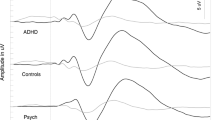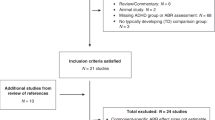Abstract
This article examines the dilemma involved in properly diagnosing children with Central Auditory Processing Deficits (CAPD) and children with Attention Deficit Disorders (without hyperactivity) (ADD) as they may not be mutually exclusive. With the help of a case illustration, the diagnostic difficulties are highlighted. There is a strong need for professionals in the speech/language and psychiatric communities to communicate to differentially diagnose a child who exhibits characteristics of both CAPD and ADD.
Similar content being viewed by others
References
American Psychiatric Association:Diagnostic and Statistical Manual of Mental Disorders (Third Edition). Washington, DC: American Psychiatric Association, 41–44, 1980.
Bain LJ:A Parent's Guide to Attention Deficit Disorders. New York: Dell Publishing, 1991.
American Psychiatric Association:Diagnostic and Statistical Manual of Mental Disorders (Third Edition—Revised). Washington, DC: American Psychiatric Association, 95, 1987.
Conners CK:Conners' Teacher Rating Scales and Conners' Parent Rating Scales. California: Western Psychological Services, 1990.
Steinhauer PD, Rae-Grant Q:Psychological Problems of the Child in the Family, Second Edition. New York: Basic Books, Inc., 1983.
CH.A.D.D. (Children with Attention Deficit Disorders):Attention Deficit Disorders: A Guide for Teachers. Florida: CH.A.D.D., 1988.
Barkley RA:Attention-Deficit Hyperactivity Disorder: A Handbook for Diagnosis and Treatment. New York: The Guilford Press, 1990.
American Psychiatric Association:Diagnostic and Statistical Manual of Mental Disorders (Fourth Edition). Washington, DC: American Psychiatric Association, 78–85, 1994.
Lindamood CH, Patricia C:The LAC Test: Lindamood Auditory Conceptualization Test. Massachusetts: Teaching Resources Corporation, 1979.
Flowers A, Costello MR, Small V:Flowers-Costello Tests of Central Auditory Abilities. Michigan: Perceptual Learning Systems, 1970.
Baker L, Cantwell DP: Attention Deficit Disorder and Speech/Language Disorders.Comprehensive Mental Health Care, 2(1):3–16, 1992.
Dalebout SD, Nelson NW, Hletko PJ, Frentheway B: Selective Auditory Attention and Children with Attention-Deficit Hyperactivity Disorder: Effects of Repeated Measurement with and without Methylphenidate.Language, Speech, and Hearing Services In Schools, 22: 219–227, 1991.
Giddan JJ: Communication Issues in Attention-Deficit Hyperactivity Disorder.Child Psychiatry and Human Development, 22(1):45–51, 1991.
Love AJ, Thompson MGG: Language Disorders and Attention Deficit Disorders in Young Children Referred for Psychiatric Services: Analysis of Prevalence and a Conceptual Synthesis.American Journal of Orthopsychiatry, 58(1): 52–64, 1988.
Ackerman PT, Dykman RA, Gardner MY: ADD Students With and Without Dyslexia Differ in Sensitivity to Rhyme and Alliteration.Journal of Learning Disabilities, 23(5): 279–283, 1990.
Keith RW, Engineer P: Effects of Methylphenidate on the Auditory Processing Abilities of Children with Attention-Deficit Hyperactivity Disorder.Journal of Learning Disabilities, 24(10): 630–636, 1991.
Geffner D, Lucker J: Assessment and Management of CAPD in ADD.ADVANCE for Speech-Language Pathologists and Audiologists, 5–42, 1994.
Semel E, Wiig EH, Secord W:Clinical Evaluation of Language Fundamentals—Revised. Texas: The Psychological Corporation, 1987.
Dunn LM, Dunn LM:Peabody Picture Vocabulary Test—L,M. Minnesota: American Guidance Service, 1981.
McNeil MR, Prescott TE:Revised Token Test. Texas: Pro-Ed, 1978.
Wabash & Ohio Valley Special Education District.MAARS. Illinois: Wabash & Ohio Valley Special Education District, 1985.
Lindamood CH, Lindamood PC:The Auditory Discrimination In Depth Program. Massachusetts: DLM Teaching Resources, 1975.
Willette R, Jackson B, Peckins I:Auditory Perception Training (APT) Auditory Figure-Ground. Illinois: Developmental Learning Materials, 1970.
Keith RW:Central Auditory and Language Disorders In Children. Ohio: College-Hill Press, Inc., 1981.
Silver LB:The Misunderstood Child. New York: McGraw-Hill Book Company, 1984.
Taylor JF:Helping Your Hyperactive Child. California: Prima Publishing & Communications, 1990.
Author information
Authors and Affiliations
Rights and permissions
About this article
Cite this article
Moss, W.L., Sheiffele, W.A. Can we differentially diagnose an attention deficit disorder without hyperactivity from a central auditory processing problem?. Child Psych Hum Dev 25, 85–96 (1994). https://doi.org/10.1007/BF02253288
Received:
Revised:
Accepted:
Issue Date:
DOI: https://doi.org/10.1007/BF02253288




